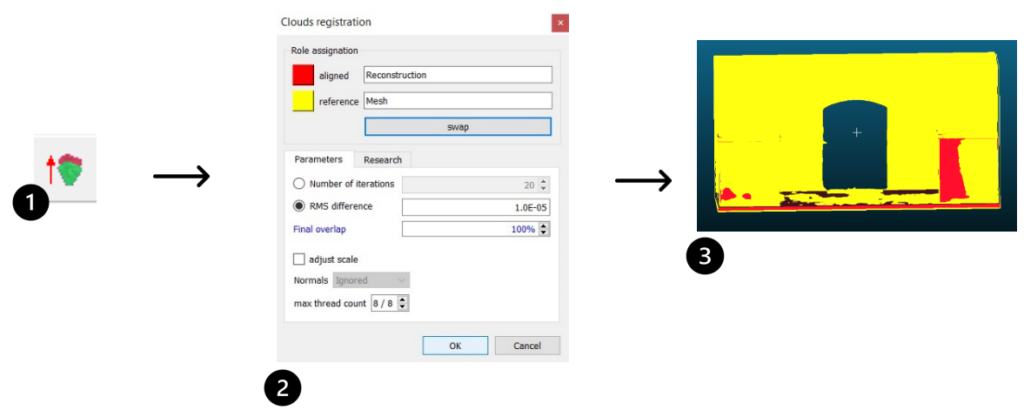Cloud Compare
Software installation: The Cloud Compare software is installed from its own web page http://www.cloudcompare.org/release/notes/20171026/ where you can find the download section, where you can download the file to the terminal from the browser itself, then unzip it and start a simple and quick automatic installation.
Comparison: In this exercise, a comparison of 2 three-dimensional entities will be carried out, in order to observe existing divergences. For this practical case, it has been decided to compare the polygonal mesh of 500,000 polygons with a rough and inaccurate 3D reconstruction, in order to observe the existing divergences in a good way.

Once installed, we initialise the programme and import 2 three-dimensional elements that we want to compare, select them and click on the “Fine Registration” button.

 Select the “Fine Registration” option to align and register both entities.
Select the “Fine Registration” option to align and register both entities.
 In the next panel “reference” we should select the model with which we want to make the comparison, usually the one that is closest to reality. The “aligned” model should be the model that is less close to reality and that you want to compare.
In the next panel “reference” we should select the model with which we want to make the comparison, usually the one that is closest to reality. The “aligned” model should be the model that is less close to reality and that you want to compare.
 Each three-dimensional entity is registered and aligned with a different colour, corresponding to the category assigned in the previous table.
Each three-dimensional entity is registered and aligned with a different colour, corresponding to the category assigned in the previous table.

Once both three-dimensional entities are registered and aligned, we proceed to calculate the distance between both entities, selecting the “compute” option according to the entities we are comparing.


 Select the option “compute cloud/mesh distance”.
Select the option “compute cloud/mesh distance”.
 We select the reference, as previously done, by assigning it to the model closest to reality.
We select the reference, as previously done, by assigning it to the model closest to reality.
 In the last box you can calibrate the accuracy and the maximum distance to be calculated.
In the last box you can calibrate the accuracy and the maximum distance to be calculated.
As a result, we will obtain a “Scalar Field” in the mesh that is less similar to reality, indicating the divergences it has with respect to the model that is closer to reality.

The comparison work carried out using Cloudcompare provides us with valuable first-hand information, which can help us to improve our models or find divergences with reality. In the same way, we also propose that you develop Lowpoly models and compare them with their corresponding Highpoly model, in order to be able to observe in each case what the inflection point of information loss is, in each model this point will vary.
